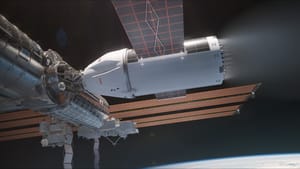
Jul 17, 2024
How SpaceX's New Dragon Will Deorbit the ISS
With the International Space Station being at the end of its lifetime, SpaceX has been selected as the provider for the United States Deorbit Vehicle (USDV) that will deorbit the 25-year-old station. Such an operation has never been done before, so how will SpaceX perform it?
On July 17th, NASA and SpaceX provided an update, via a teleconference, on the USDV and the deorbit operation. A render of SpaceX's new Cargo Dragon-derived spacecraft was released too and shows an unknown Cargo Dragon of the current SpaceX fleet equipped with a trunk, twice the size of the standard one, carrying 16 tons of propellant.
The Launch of the USDV
It was announced that NASA expects the re-entry of the ISS to occur somewhere around January 2031, and the USDV to launch a year and a half before that ( around July 2030). It should be noted that a weakness the Source Evaluation Board found in SpaceX's approach was the uncertainty of SpaceX's ability to make it in time.
With the dry mass of the new Dragon likely being over 10 tons and the new Dragon carrying 16 tons of propellant, the Falcon-9 does not have enough performance to get it to the desired orbit and inclination, and a heavier class launch vehicle will be needed, presumably a Falcon-Heavy.
Steering
It was confirmed on the teleconference that the steering and docking of the USDV will likely be a combination of autonomous steering and input from mission control, just like it is for the Cargo Dragon.
The Engine Setup
The render also shows the trunk equipped with what was confirmed to be 30 of SpaceX's current Draco thrusters as well as the usual 16 on the capsule. SpaceX appears to have gained even more confidence in controlling numerous engines, as this setup will total 46 Dracos.
It was also stated that up to 26 Dracos will be firing simultaneously. Assuming they all fire at maximum power, a thrust of 10400 Newtons will be achieved. Doing a bit of math, we can calculate an acceleration of 0.023 m/s². In a whitepaper released on June 26th, NASA claimed a delta-v of 57 m/s would be needed to deorbit the station. This would make a very long burn of 2478 seconds or about 41 minutes, making it one of, if not the, longest chemical burn ever performed in space.
Deorbit
Just after the last crew exchange, the USDV will launch and dock to the ISS on what looks to be the IDA 2. The ISS will then be allowed to drift down, which it will do for about a year. The crew will stay until about 6 months before the re-entry when the station is a little under 300 km high, where they will then say their final goodbye to the ISS and undock one last time.
When the station has drifted to an altitude of about 220 km, the USDV will perform some set-up burns to orient the station, before eventually performing the deorbit burn. According to NASA, the solar arrays and other smaller components will burn up entirely, while other things will potentially splash down in a 2000 km long zone in the South Pacific Ocean.
Questions
NASA did not provide any information on whether the station will see upgrades to its structural integrity to avoid space debris, or if reinforcements will be made to the forward port where the USDV will dock since it will have to take the load of 26 Dracos.
It also appears that NASA does not know whether mementos of the station will be brought back to Earth before re-entry.



